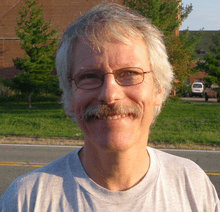Paul E. Olsen
| Paul E. Olsen | |
|---|---|
 | |
| Born |
4 August 1953 New Jersey, USA |
| Nationality | Danish-Ukrainian American |
| Fields | paleontology, geology |
| Institutions | Lamont Doherty Earth Observatory |
| Alma mater | Yale University |
| Known for | Newark Supergroup |
Paul E. Olsen (born August 4, 1953) is an American paleontologist and author and co-author of a large number of technical papers. Growing up as a teenager in Livingston, New Jersey, he was instrumental in Riker Hill Fossil Site being named a National Natural Landmark as a teenager by sending President Richard Nixon a dinosaur footprint cast from the site.[1][2][3] He received a M. Phil. and a Ph.D. in Biology at Yale University in 1984. His thesis was on the Newark Supergroup.
His interests and research examine patterns of ecosystem evolution and extinction as a response to climate change over geological time, and Triassic and Jurassic Continental Ecosystems. His research methods include structural geology, paleontology, palynology, geochemistry, and geophysics.
Professor Olsen is currently Arthur D. Storke Memorial Professor of Earth and Environmental Sciences, Department of Earth and Environmental Sciences, Lamont–Doherty Earth Observatory at Columbia University; Research Associate at the Carnegie Museum of Natural History, Pittsburgh, the American Museum of Natural History and the Virginia Natural History Museum; Vice President, Board of Directors, Black Rock Forest Consortium, and on the Honorary Board of Directors, Fundy Geological Museum, Parrsboro, Nova Scotia.
Recent publications
- Peter LeTourneau and Paul Olsen (ed.), (2003) The Great Rift Valleys of Pangea in Eastern North America, vol. 1-2, published by Columbia University Press. Volume 1: Tectonics, Structure, and Volcanism (ISBN 0-231-11162-2), Volume 2: Sedimentology,Stratigraphy, and Paleontology (ISBN 0-231-12676-X)
In production
- Olsen, Paul E., Dinosaur and Other Fossil Tracks of Eastern North America: Columbia University Press
References
- ↑ Kleiman, Miriam (2009). "Amateur Teenage "Dinosaur Hunter's" Find Ends up in the National Archives". National Archives. Retrieved 2009-05-23.
- ↑ "Essex Fossil Site Now a Landmark". The New York Times. July 22, 1973. Retrieved 2009-03-09.
- ↑ Staff. Foot Forward, Lamont–Doherty Earth Observatory, March 31, 2009. Accessed February 24, 2011. "In 1968, 14-year-old Paul Olsen of suburban Livingston, N.J., and his friend Tony Lessa heard that dinosaur tracks had been found in a nearby quarry. They raced over on their bikes. 'I went ballistic,' Olsen recalls. Over the next few years, the boys uncovered and studied thousands of tracks and other fossils there, often working into the night. It opened the world of science to Olsen; he went on to become one of the nation’s leading paleontologists."